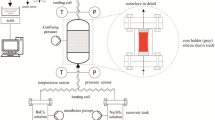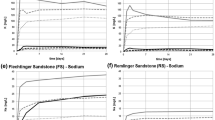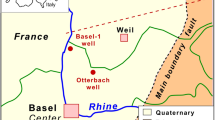Abstract
In the course of stimulation and fluid production, the chemical fluid–rock equilibrium of a geothermal reservoir may become disturbed by either temperature changes and/or an alteration of the fluid chemistry. Consequently, dissolution and precipitation reactions might be induced that result in permeability damage. In connection with the field investigations at a deep geothermal doublet, complementary laboratory-based research is performed to address these effects. The reservoir is located at a depth of 4100 to 4200 m near Groß Schönebeck within the Northeast German Basin, 50 km north of Berlin, Germany. Within the reservoir horizon, an effective pressure of approximately 45 MPa and a temperature of 150°C are encountered. Furthermore, the Lower Permian (Rotliegend) reservoir rock is saturated with a highly saline Ca–Na–Cl type formation fluid (TDS ≈ 255 g/l). Under these conditions we performed two sets of long-term flow-through experiments. The pore fluid used during the first and the second experiment was a 0.1 molar NaCl-solution and a synthetic Ca–Na–Cl type fluid with the specifications as above, respectively. The maximum run duration was 186 days. In detail, we experimentally addressed: (1) the effect of long-term flow on rock permeability in connection with possible changes in fluid chemistry and saturation; (2) the occurrence and consequences of baryte precipitation; and (3) potential precipitations related to oxygen-rich well water invasion during water-frac stimulation. In all substudies petrophysical experiments related to the evolution of rock permeability and electrical conductivity were complemented with microstructural investigations and a chemical fluid analysis. We also report the technical challenges encountered when corrosive fluids are used in long-term in situ petrophysical experiments. After it was assured that experimental artifacts can be excluded, it is demonstrated that the sample permeability remained approximately constant within margins of ±50 % for nearly six months. Furthermore, an effect of baryte precipitation on the rock permeability was not observed. Finally, the fluid exchange procedure did not alter the rock transport properties. The results of the chemical fluid analysis are in support of these observations. In both experiments the electrical conductivity of the samples remained unchanged for a given fluid composition and constant p-T conditions. This emphasizes its valuable complementary character in determining changes in rock transport properties during long-term flow-through experiments when the risk of experimental artifacts is high.
Similar content being viewed by others
References
Aharonov E., Tenthorey E., Scholz C.H.: Precipitation sealing and diagenesis: 2. Theoretical analysis. J. Geophys. Res. 103(B10), 23969–23981 (1998). doi:10.1029/98JB02230
Bear J.: Dynamics of fluids in porous media. Dover Publication, Inc., Mineola, NY (1988)
Blöcher, G., Moeck, I., Milsch, H., Zimmermann, G.: Modelling of pore pressure response due to hydraulic stimulation treatments at the geothermal research doublet EGrSk3/90 and GtGrSk4/05 in summer 2007. In: Proceedings, 33rd Workshop on Geothermal Reservoir Engineering, Stanford University, Stanford, California, SGP-TR-185 (2008)
Darcy H.: Les fontaines publique de la ville de Dijon. Dalmont, Paris (1856)
De Boer R.B., Nagtegaal P.J.C., Duyvis E.M.: Pressure solution experiments on quartz sand. Geochim. Cosmochim. Acta 41, 257–264 (1977). doi:10.1016/0016-7037(77)90233-2
Dunn K., Daniel E., Shuler P.J., Chen H.J., Tang Y., Yen T.F.: Mechanisms of surface precipitation and dissolution of baryte: a morphology approach. J. Colloid Interface Sci. 214(2), 427–437 (1999). doi:10.1006/jcis.1999.6224
Giese, L., Seibt, A., Wiersberg, T., Zimmer, M., Erzinger, J., Niedermann, S., et al: Geochemie der Formationsfluide. In: Huenges, E., Hurter, S. (eds.) In-situ Geothermielabor Groß Schönebeck: Bohrarbeiten, Bohrlochmessungen, Hydraulik, Formationsfluide, Tonminerale. Scientific Technical Report, STR02/14, GeoForschungsZentrum Potsdam, Potsdam, Germany (2002)
Giger S.B., Tenthorey E., Cox S.F., Fitz Gerald J.D.: Permeability evolution in quartz fault gouges under hydrothermal conditions. J. Geophys. Res. 112, B07202 (2007). doi:10.1029/2006JB004828
Gratier J.P., Guiguet R.: Experimental pressure solution-deposition on quartz grains: the crucial effect of the nature of the fluid. J. Struct. Geol. 8(8), 845–856 (1986). doi:10.1016/0191-8141(86)90030-1
Kühn M., Frosch G., Kölling M., Kellner T., Althaus E., Schulz H.D.: Experimentelle Untersuchungen zur Barytübersättigung einer Thermalsole. Grundwasser 3, 111–117 (1997)
Legarth B., Huenges E., Zimmermann G.: Hydraulic fracturing in a sedimentary geothermal reservoir: results and implications. Int. J. Rock Mech. Min. Sci. 42, 1028–1041 (2005). doi:10.1016/j.ijrmms.2005.05.014
Lemée C., Guéguen Y.: Modelling of porosity loss during compaction and cementation of sandstones. Geology 24, 875–878 (1996). doi :10.1130/0091-7613(1996)024<0875:MOPLDC>2.3.CO;2
Martys N.S., Garboczi E.J.: Length scales relating the fluid permeability and electrical conductivity in random two-dimensional porous media. Phys. Rev. B 46, 6080–6090 (1992). doi:10.1103/PhysRevB.46.6080
Milsch H., Spangenberg E., Kulenkampff J., Meyhöfer S.: A new apparatus for long-term petrophysical investigations on geothermal reservoir rocks at simulated in-situ conditions. Transp. Porous Med. 74, 73–85 (2008). doi:10.1007/s11242-007-9186-4
Moeck I., Schandelmeier H., Holl H.-G.: The stress regime in a Rotliegend reservoir of the Northeast German Basin. Int. J. Earth Sci. (2008). doi:10.1007/s00531-008-0316-1
Omar A.E.: Effect of brine composition and clay content on the permeability damage of sandstone cores. J. Petrol. Sci. Eng. 4, 245–256 (1990). doi:10.1016/0920-4105(90)90014-T
Rutter E.H.: The kinetics of rock deformation by pressure solution. Philos. Trans. R. Soc. London. Ser. A 283, 203–219 (1976)
Scheidegger A.E.: The physics of flow through porous media. University of Toronto Press, Toronto (1974)
Seibt, A.: Welche Faktoren können die Eisen(II)-Oxidation in Formationswässern beeinflussen? In: Huenges, E. (ed.) Geothermische Energieentwicklung—geologische und energietechnische Ansatzpunkte. Scientific Technical Report, STR00/23, GeoForschungsZentrum Potsdam, Potsdam, Germany (2000)
Small J.S., Hamilton D.L., Habesch S.: Experimental simulation of clay precipitation within reservoir sandstones: 1. Techniques and examples. J. Sediment. Petrol. 62, 508–519 (1992)
Sprunt E.S., Nur A.: Destruction of porosity through pressure solution. Geophysics 42, 726–741 (1977). doi:10.1190/1.1440742
Tada R., Maliva R., Siever R.: A new mechanism for pressure solution in porous quartzose sandstone. Geochim. Cosmochim. Acta 51, 2295–2301 (1987). doi:10.1016/0016-7037(87)90282-1
Tenthorey E., Scholz C.H., Aharonov E., Léger A.: Precipitation sealing and diagenesis: 1. Experimental results. J. Geophys. Res. 103(B10), 23951–23967 (1998). doi:10.1029/98JB02229
Terzaghi K.: Die Berechnung der Durchlässigkeitsziffer des Tones aus dem Verlauf der hydrodynamischen Spannungserscheinungen. Sitz. Akad. Wiss. Wien, Math. Naturwiss. Kl., Abt. IIa 132, 105–124 (1923)
Yasuhara H., Polak A., Mitani Y., Grader A.S., Hallek P.M., Elsworth D.: Evolution of fracture permeability through fluid-rock reaction under hydrothermal conditions. Earth Planet. Sci. Lett. 244, 186–200 (2006). doi:10.1016/j.epsl.2006.01.046
Author information
Authors and Affiliations
Corresponding author
Rights and permissions
About this article
Cite this article
Milsch, H., Seibt, A. & Spangenberg, E. Long-term Petrophysical Investigations on Geothermal Reservoir Rocks at Simulated In Situ Conditions. Transp Porous Med 77, 59–78 (2009). https://doi.org/10.1007/s11242-008-9261-5
Received:
Accepted:
Published:
Issue Date:
DOI: https://doi.org/10.1007/s11242-008-9261-5




